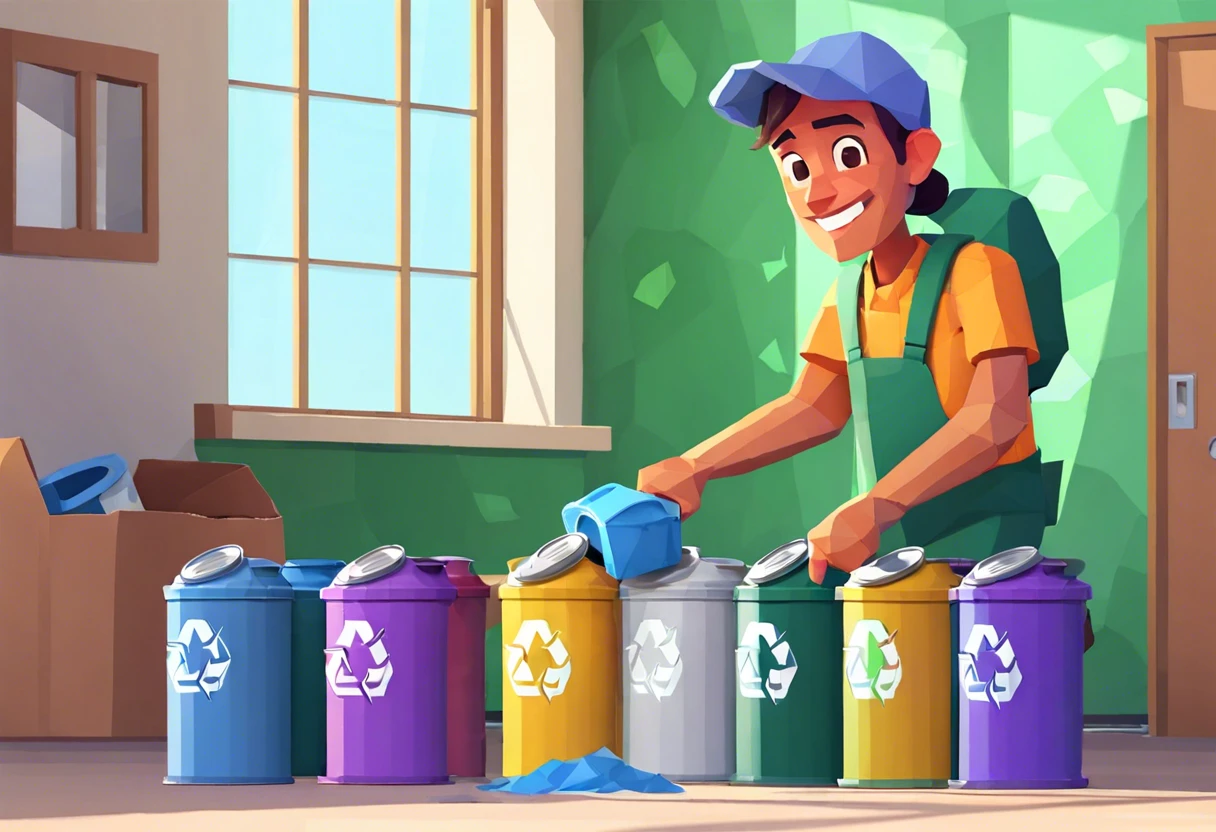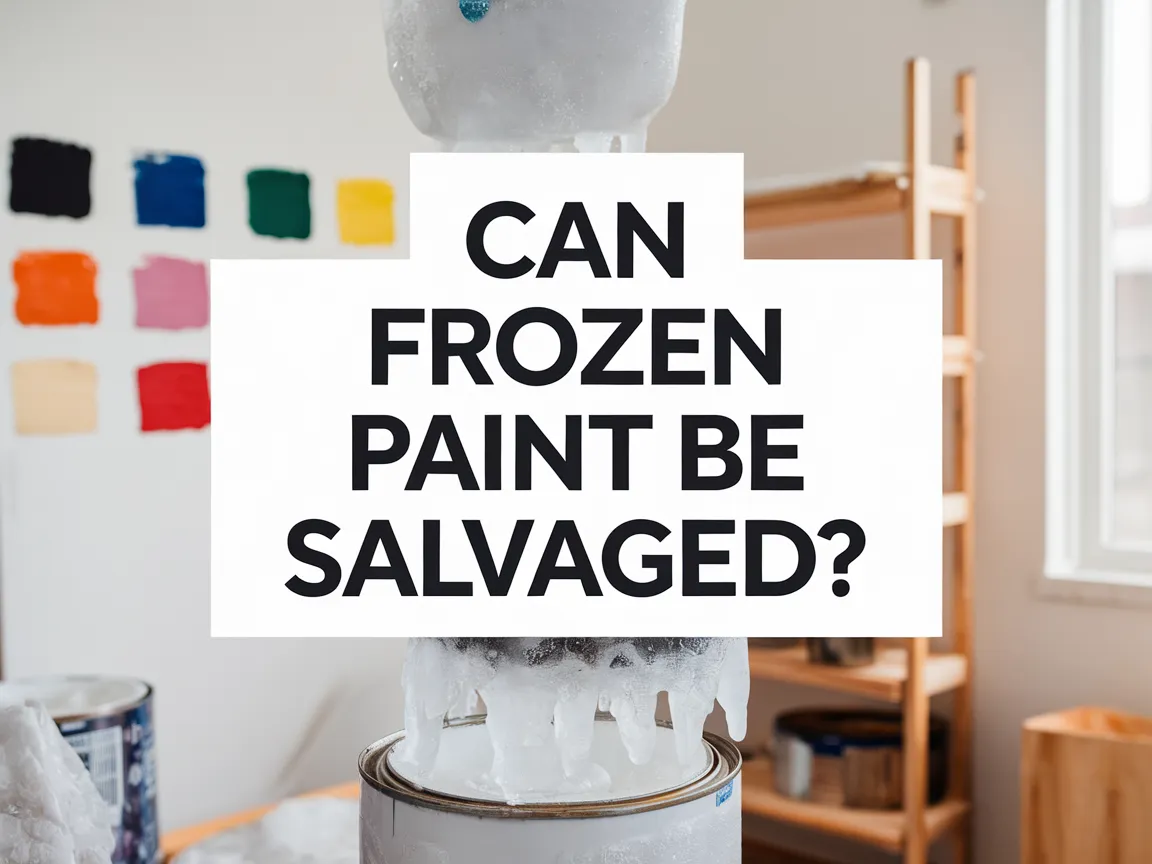How Do You Dispose Of Empty Paint Cans?
Empty paint cans are the metal or plastic containers that once held paint. They’re like little homes for colors that have now run dry.
So, how do you dispose of empty paint cans? It’s super important to do it right! I’ve learned the hard way that just tossing them in the trash can lead to problems for our environment and local waste systems.
In this guide, we’ll cover the steps to safely get rid of empty paint cans, what to think about before disposing of them, the types you might have, and even creative ways to repurpose them. You’ll learn where to take old paint and how to handle it responsibly.
Contents
- 1 How Do You Dispose Of Empty Paint Cans?
- 2 What Are Empty Paint Cans?
- 3 What to Consider Before Disposing Of Empty Paint Cans
- 4 Step-by-step Guide to Disposing Of Empty Paint Cans
- 5 Types Of Empty Paint Cans and Their Disposal
- 6 Factors Affecting the Disposal Of Empty Paint Cans
- 7 Common Issues When Disposing Of Empty Paint Cans
- 8 Finishing Touches: Ensuring Proper Disposal
- 9 Alternative Disposal Methods for Empty Paint Cans
- 10 What to Do With Leftover Paint in Your Cans
- 11 Local Resources for Paint Can Disposal
- 12 Understanding Local Disposal Regulations
- 13 The Environmental Impact of Properly Disposing of Empty Paint Cans
- 14 Innovative Disposal Solutions for Artists and Crafters
- 15 Frequently Asked Questions About Disposing Of Empty Paint Cans
- 16 Conclusion: Best Practices for Disposing Of Empty Paint Cans Responsibly
- 17 Additional Resources
How Do You Dispose Of Empty Paint Cans?
To get rid of empty paint cans, first ensure they’re completely dry. Then, check local regulations for disposal options. Many recycling or waste centers accept these cans. Always remove lids to prevent hazardous waste issues.
What Are Empty Paint Cans?
Empty paint cans are containers typically made of metal or plastic, with standard capacities ranging from 1 quart (0.946 Liters) to 5 gallons (18.9 Liters).
The Finishing Touch
A freshly painted wall is a blank canvas. The best way to bring your room to life is with a single piece of statement art that ties everything together.
Browse Wall Art at Big Wall DecorWhen it comes to disposal, you can’t toss them in the regular trash. I’ve dealt with how to properly dispose of empty paint cans while navigating local regulations, which often vary by community. If you’re considering refreshing your space, you might want to explore professional bathtub painting techniques that can breathe new life into your bathroom.
I used them frequently for my job, especially when transforming spaces with a fresh coat of paint. Learning about empty paint can disposal opened my eyes—did you know you can sometimes return them to paint retailers? Finding a safe, eco-friendly way to discard those old containers makes a big difference!
What to Consider Before Disposing Of Empty Paint Cans
What do you need to prepare for?
- Container: Use a sturdy container, like a 19-liter (5-gallon) bucket with a lid, to safely hold and transport the cans.
- Protective Gear: Wear gloves (Like Nitrile) and a mask (N95 or Better) to protect against harmful residues and fumes during disposal.
- Labels: Keep adhesive labels, like UL-approved ones, to mark contents clearly and ensure safety.
- Local Regulations: Check your area’s disposal guidelines, as regulations can vary significantly and outline where to dispose of paint cans responsibly.
We covered factors to consider when disposing of empty paint cans. We will now cover a step-by-step disposal guide.
Also See: How Much Does It Cost to Fix Chipped Car Paint?

Step-by-step Guide to Disposing Of Empty Paint Cans
Here are the steps to effectively and safely dispose of empty paint cans.
-
Check Local Regulations
First, find out your local rules regarding empty paint cans. Different areas have different regulations, so check with local waste management or city websites—it’s crucial!
Some cities might have specific pickup days or designated drop-off sites. Ignoring local guidelines could lead to fines, so don’t skip this step.
-
Prepare the Paint Cans
Make sure your empty paint cans are completely dry. Leave them open in a well-ventilated area to let residual paint harden, which usually takes about 24 hours, depending on temperature.
Once dry, remove any lids for recycling. It’s also a good idea to label the cans as “empty” if there’s any confusion at the recycling location.
-
Identify Recycling Options
Next, look for recycling centers that accept empty paint cans. Many local facilities will take them, especially if they’re metal or plastic.
I recommend calling ahead to confirm what types they accept and their hours of operation. Some paint retailers also have recycling programs, so check with them.
-
Find Safe Disposal Methods
If recycling isn’t an option, always choose safe disposal methods. Check if your area has hazardous waste events where you can drop off not just the cans, but any leftover paint.
These events keep hazardous materials like residual paint out of landfills and protect the environment. Ensure you dispose of empty paint cans properly for a smaller carbon footprint!
We’ve wrapped up the step-by-step guide for disposing of empty paint cans here. Let us turn our attention to the types of empty paint cans and their disposal.
The Finishing Touch
A freshly painted wall is a blank canvas. The best way to bring your room to life is with a single piece of statement art that ties everything together.
Browse Wall Art at Big Wall DecorTypes Of Empty Paint Cans and Their Disposal
Let’s move on to the types: metal, plastic, aerosol, and cardboard paint cans.
-
Metal Paint Cans
Metal paint cans are the most common type, typically holding 1 quart (0.946 Liters) to 5 gallons (18.927 Liters). To dispose of them, clean them thoroughly and check local recycling regulations for options.
-
Plastic Paint Cans
Plastic cans usually hold the same amount as metal containers, ranging from 1 quart (0.946 Liters) to 5 gallons (18.927 Liters). Make sure to empty them completely and recycle according to local guidelines.
-
Aerosol Paint Cans
Aerosol cans are smaller and typically contain about 12 ounces (0.355 Liters). These should never go in regular trash; locate a hazardous waste disposal site for safe disposal of empty aerosol cans.
-
Cardboard Paint Cans
While less common, cardboard paint cans hold around 1 quart (0.946 Liters). Like metal cans, check if your local recycling service accepts them or look for specialty disposal options.
From my experience, tackling metal paint cans is the easiest. They’re often recyclable, making disposal convenient!
We covered the various types of empty paint cans and how to dispose of them. We will now cover disposal factors.
Factors Affecting the Disposal Of Empty Paint Cans
So, what factors influence how you handle empty paint containers?
-
Local regulations: Different areas have specific rules for disposing of paint cans.
-
Can condition: If a can contains dried paint, it affects your disposal options.
-
Type of paint: Oil-based paints often require special handling compared to water-based paints.
-
Collection services: The availability of local drop-off sites significantly impacts your disposal choices.
We covered the factors influencing the disposal of empty paint cans. We will now cover typical problems encountered during disposal.

Common Issues When Disposing Of Empty Paint Cans
My friend once struggled to figure out how to dispose of empty paint cans. She learned that tossing them in the trash isn’t safe.
Instead, she discovered that local recycling options or hazardous waste facilities can take them. Most places recycle cans if they are completely empty and dry. Easy peasy!
Finishing Touches: Ensuring Proper Disposal
After handling those pesky empty paint cans, seal them tightly to prevent leaks. Check the attached lids—ensure they’re secure to avoid messy surprises later.
Inspect the inside for leftover paint, aiming for none. Use a small brush, like the Purdy 144152300, to verify it’s completely empty; aim for less than 5 milliliters (0.17 Fl Oz) of residue.
As a tip, consider securely fastening each can’s lid with tape before disposal. This prevents shifting and ensures the process meets strict industry safety standards during transportation.
Alternative Disposal Methods for Empty Paint Cans
Looking for different ways to handle those empty paint cans? Here are some creative disposal options!
-
Retailer Take-Back Programs
Many paint retailers have programs where you can return empty cans. Big stores like Home Depot and Lowe’s offer these services. It’s a great win-win— you get rid of your cans, and they recycle them! If you’re wondering about mixing different paint types, paint recycling and techniques require careful consideration.
-
Community Recycling Events
Keep an eye out for community recycling days. These events often include paint can disposal, allowing you to drop off your cans at no cost. Check local websites for dates and locations.
The Finishing Touch
A freshly painted wall is a blank canvas. The best way to bring your room to life is with a single piece of statement art that ties everything together.
Browse Wall Art at Big Wall DecorWhat to Do With Leftover Paint in Your Cans
Wondering how to handle leftover paint in your cans? Here’s what you can do.
-
Dry It Out
If you have a small amount of latex paint left, pour it out onto cardboard or newspaper and let it dry. Once fully dry, dispose of it with your regular trash.
-
Take It to a Hazardous Waste Facility
For oil-based paints or larger amounts, take them to a hazardous waste facility. They know how to deal with these safely!
-
Participate in Community Events
Check for local “paint swap” or recycling events. Painting enthusiasts might gladly take your leftover paint for their projects!
Local Resources for Paint Can Disposal
Finding the right places for paint can disposal is key! Here’s a table with potential local resources:
| Resource Type | Description | Example Location |
|---|---|---|
| Municipal Drop-off Centers | Locations for residents to drop off waste, including paint cans. | City Recycling Center |
| Local Paint Retailers | Stores that accept empty cans for recycling or will provide disposal options. | Home Depot |
| Hazardous Waste Collections | Scheduled community events for disposing of hazardous materials, including paint. | Monthly City Clean-Up Event |
Understanding Local Disposal Regulations
Each area has its own rules. Here’s a quick guide to understand what you need to know:
- Know Your Zones: Some neighborhoods might have stricter rules.
- Check Online: Visit your city’s waste management website for up-to-date info.
- Call Ahead: If unsure, a quick phone call can clarify what’s accepted.
The Environmental Impact of Properly Disposing of Empty Paint Cans
Why does proper disposal matter? Let’s break down some key points about the environment.
| Impact Area | Benefit of Proper Disposal | Statistics |
|---|---|---|
| Landfill Space | Reduces the amount of waste | Approximately 3.1 million tons of paint waste are avoided in landfills annually. |
| Pollution | Prevents harmful chemicals from leaking | Improper disposal can release toxins into the environment, affecting ecosystems. |
| Recycling | Supports the recycling industry | Recycling paint cans can save up to 92% in energy costs compared to new material production. |
Innovative Disposal Solutions for Artists and Crafters
Are you an artist or crafter looking for unique ideas? You have options for using those empty paint cans!
-
Art Supply Storage
Use them to store brushes, paints, and other supplies. Give them a funky paint job for easy identification!
-
Creative Plant Holders
Transform paint cans into colorful planters. Just remember to drill drainage holes!
-
Recyclable Art Projects
Organize community art events to repurpose cans into sculptures. Think of it as a fun way to engage with others while promoting recycling!
Also See: How Much Does It Cost to Get a Truck Painted?
Frequently Asked Questions About Disposing Of Empty Paint Cans
What Should I Do if My Paint Can Still Has Some Residual Paint?
Yes, if your paint can still has some residual paint, it’s important to properly handle it. Generally, you should allow the paint to dry out completely before disposing of the can. This prevents any leakage, and studies show that this safe drying method reduces environmental impact.
Can I Throw Empty Paint Cans in the Regular Trash?
No, you shouldn’t throw empty paint cans in the regular trash. Many areas require recycling these cans instead for environmental protection, as 2.5 million tons of waste paint are generated in the U.S. every year. If you’re wondering about alternative uses for leftover paint, you might want to explore creative ways to repurpose acrylic paint.
What is the Best Way to Clean Out Paint Cans?
The best way to clean out paint cans is to scrape out the excess paint with a paddle or spatula. Ensure you wear gloves. This can save you disposal costs, and allow you to recycle the cans more easily. If you’re working on a larger painting project like a mural, you might want to explore specific techniques for preparing acrylic paint for murals.
Are There Any Eco-friendly Disposal Options for Paint Cans?
Yes, eco-friendly disposal options for paint cans include local recycling programs and hazardous waste collection events. Many municipalities have these options to reduce landfill waste, significantly cutting down on pollution. If you’re looking to explore alternative paint uses, you might want to transform your leftover acrylic paint into creative projects.
Can I Recycle Paint Cans With Dried Paint Still Inside?
No, you can’t recycle paint cans with dried paint still inside. Make sure to remove any solid residue; most recycling facilities won’t accept them otherwise. This practice helps maintain the integrity of recyclable materials by 50%. If you’re looking to refresh your space, you might want to explore painting tile surfaces effectively.
Where Can I Take Old Paint That’s Not in Cans?
You can take old paint that’s not in cans to local hazardous waste collection sites. Many communities offer free disposal days to manage toxic waste responsibly. Check with your local waste facility to find out options near you. If you’re considering refreshing your space, you might want to explore painting your bathroom vanity for a quick home update.
How Do I Know if My Empty Paint Can is Recyclable?
To know if your empty paint can is recyclable, check for label symbols like the recycling ♻️ logo. Most metallic cans without paint residue are accepted, making recycling easy and reducing overall waste from landfills. If you’re dealing with older paint containers that might contain hazardous materials, you’ll want to understand proper paint disposal techniques.
Conclusion: Best Practices for Disposing Of Empty Paint Cans Responsibly
In conclusion, we’ve explored the definition of empty paint cans, important disposal considerations, a detailed paint can disposal guide, various disposal methods, contributing factors, common challenges, and creative DIY repurposing ideas.
To summarize, disposing of empty paint cans is straightforward: consult your local recycling guidelines or visit a hazardous waste facility, ensuring the cans are entirely empty and clean.
If you found this information useful, check out more resources and insights at Paint Answers.
Additional Resources
- Edwards, B. (2012). Drawing on the Right Side of the Brain. New York, NY: TarcherPerigee.
- Guide to managing paint waste | Metro
- How to Store and Dispose of Paint | Lowe’s
- Water-based paint | Metro
Isabella is a Filipino-American art writer and critic specializing in contemporary painting, blending her Filipino heritage with global art trends. She holds a BFA from California State University, Long Beach, and a Minor in Art History from the University of the Philippines. Isa has experience as a Gallery Assistant, Art Appraisal Specialist, and Social Media Creative for Art & Design.
Disposal, Misc.









